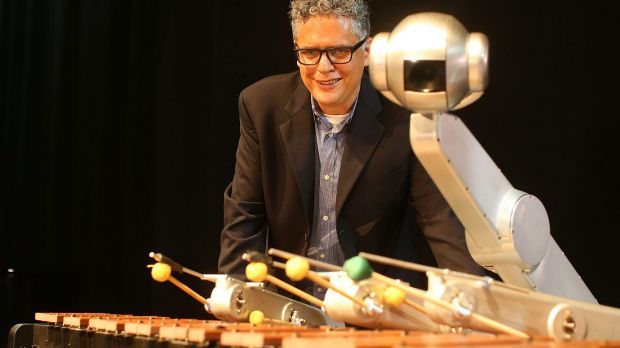Further musings on AI, programming and music
Graham kept thinking…
… about AI and programmed music, as previously discussed by us chaps, and the differences, and some subtle gradations. Yes, some machine-generated music is surely programmed, following a routine established by the “author.” This, for example, while lovely, is clearly an analog-programming-generated piece:
as is this …
and this …
Except, of course that the two above are not – they are animations of what appear to be programmed installations. Although just to confuse the issue, here’s a version of Pipe Dream played ‘live’ by an Intel controller …
So: simulations of programmed music, but actually ‘played’ by the animators. But did the creators use programmed animation, or animate it themselves?
Going on then from simulations of programmed music: what does that make this?
Or this – a robot replication of a band that specialises in imitating robots and replicating that with robots.
Could the band as readily be replaced by good animatronics? And if Kraftwerk-as-robots is indistinguishable from robots-as-Kraftwerk – in their same non-response as the ‘real’ ones. Are they passing a musical Turing Test?
And on a slightly different, er, note [the other chap notes that this was a clever pun] … it’s not too long ago that we were almost graced with bars around the country featuring animatronic versions of Norm and Cliff from Cheers. The project foundered on a copyright dispute, eventually bringing in their ‘owners’ zero royalties for their legal pains. (Way to go, George and John.)
But what now? With 2017 animatronic capabilities, let’s just look back at the Shimon AI musician that began this train of thought …
… could we, would we, should we have near-real Cliff-and-Norms in our neighbourhoods? Maybe in the sort of bar that serves near-real beer, the sort of beer that sponsors near-robots? But that’s another thing …
John is now firmly pulling his hair out
‘near-real-beer’ - surely you jest doctor? It is either beer. Or it is not.
… and the Cliff and Norm story is yet another example that needs to be filed in the ‘just because you could doesn’t mean you should’ drawer of your nearest filing cabinet. In fact file it twice. Once for the idea to begin with. And second for going to court over it!
And Another Thing
Music is but a language. Not as narrowly defined as English or Mandarin I grant, but definitely as ‘universal’ as Mathematics. Language in turn allows for communication. And if you look deep inside that device in your hand or on your lap - or maybe even on your desk, where you are reading this (unless you are like my dad and have printed this out and are reading this on a piece of paper … in which case you are exempt from this comparison) … you will know that it must have communication protocols somewhere within to allow it to communicate with other devices, from wherever this article is stored. Those communication protocols and languages are well documented.
Moreover - we also know that computers are beginning to understand human language … think ‘Heh Siri’, ‘Alexa’ or even over in Google Translate.
Bottom line, computers have been communicating with each other for a few decades .. and are now beginning to understand how to communicate with humans using language and certainly Maths.
and definitely with their own versions of
Afterall, we are more than likely already part of a simulation - so why wouldn’t the simulations simulate?
AND (Yet) ANOTHER THING
Why does a language like Maths that can barely describe the planet we live on, much less the Universe get to be called ‘universal’?
This chap believes that to be an original thought and not a spin on a Steve Wrightism.
